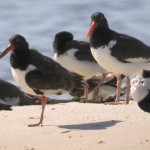American Oystercatchers
Studying Migration in New Jersey
By Alfred Breed, Seasonal Field Technician

Species diversity is critical for the continued health of any ecosystem. All organisms have a role to play, but defining that role for any species is no easy task. Certain species might act as a keystone, one whose healthy presence is absolutely required. Others might serve the role of an indicator species, the proverbial canary in the coal mine, with the health of that species being a sign of the health of the overall system. Without data, we cannot know. While data has been collected for several years for breeding and wintering populations of American Oystercatcher in New Jersey, very little data has been collected during migration. Collecting that data is my job at the moment.
The American oystercatcher is a species of special concern in the state of New Jersey. Causes for concern include their low population and risky breeding strategy, combined with habitat degradation from pollution, habitat loss from development, as well as increased predation and disturbance directly related to human activities within their habitat.
Although oystercatcher pairs will fiercely defend a territory from other oystercatchers during nesting season, in the fall and early winter they are almost always to be found hanging out together either at the beach or on the marsh. They can generally be relied on during the non-breeding season to roost in flocks near ocean inlets, but locating the flock and approaching to within band-resighting distance during a limited high-tide time frame can be challenging.
An ocean inlet can encompass a very large area; and when your quarry can fly and you can’t, that area can seem even larger! Just finding the flock and getting to an effective observation point (which even with quality optics is surprisingly close) without them “spooking” is more than half the battle. Using a boat or kayak, combined with marsh trekking and the occasional swim, there are few places the oystercatchers go where they cannot be followed and discretely observed.
The goal of this field research is to collect data on roosting flocks of American oystercatchers at southern New Jersey Atlantic coastal inlets during migratory season. The data collected also enables further research on life-span, survival rates, movement patterns, population, age structure and other important characteristics.
I’m incredibly fortunate to be a part of this important research collecting data vital to our understanding of this species, while at the same time being privileged to be able to enjoy and become more intimately familiar with our beautiful southern New Jersey coastal ecosystem. We would like to thank the National Fish and Wildlife Foundation for funding this important research.